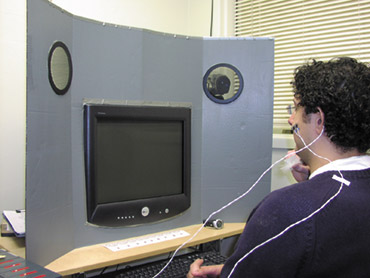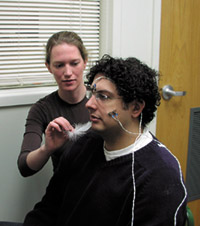Researcher examines sensory disorders
Many people suffer from certain smells, sights, touches, tastes and sounds that most others find pleasant, at best, or mildly irritating, at worst.

Graduate students test sensory protocol in the lab of Julia Wilbarger, an assistant professor of kinesiology. Wilbarger has examined how sensory-processing disorders affect occupational therapy patients.
About 5–10 percent of people around the world suffer from sensory defensiveness, or sensory processing disorders, with varying levels of acuteness, says Julia Wilbarger, an assistant professor in the Department of Kinesiology.
Sensory processing research is about 30 years old but has become an increasingly hot topic in occupational therapy (OT) for the past 10–15 years. Therapists encounter sensory-processing disorders in significant enough portions of their clients that practitioners flood the workshops Wilbarger gives in the United States and abroad.
Most people ignore minor stimuli of which our ancestors may have been more aware. These stimuli may have served as warning signals to induce protective behaviors. But people with sensory defensiveness remain keenly aware of many subtle stimuli — such as a clothing tag that feels like a spider crawling on their skin — some to the point of severe psychological and physical reaction, Wilbarger says.

Wilbarger has recently begun studying oversensitivities among children with autism and women with fibromyalgia.
Furthermore, someone who is oversensitive to one type of stimulus will probably be oversensitive to many others, she says.
Wilbarger became intrigued by these sensory-processing mysteries during her first 10 years as a clinician working with children.
“I saw problems with children just managing their daily lives,” she says, explaining that she began recognizing the sensory-processing issues underlying those problems.
She returned to graduate school to get a doctorate so that she could explore this little-studied phenomenon.
“Very few people are examining this area… but a lot of people seem to have this condition,” she says.
She stumbled upon a condition that clinicians around the world encounter but have no scientifically backed explanation or treatment to rely on.
After joining the occupational therapy faculty, Wilbarger began collaborating with UW–Madison professors Mary Schneider and Seth Pollack and University of Minnesota Professor Megan Gunnar on a study of internationally adopted children with sensitivity disorders.
“We found that internationally adopted children who spent more time in a institution or orphanage had more sensory processing problems compared with non-adopted children and internationally adopted children who either spent a brief time in institutions or were in foster care,” she says.
Wilbarger recently began studying oversensitivities among children with autism and women who suffer from fibromyalgia.
Wilbarger applies methods that have been used to identify sensory-processing issues in children to adults.
She uses a modified version of a “sensory challenge” originally developed by her colleagues when she was working on a research team with Lucy Miller, director of the Sensory Processing Disorder Foundation.
The original sensory challenge recorded subjects’ physiological responses to different sensations that were chosen based on clinical observation and parents’ reports of what was most bothersome to children with sensory-processing disorders.
“The sensory challenge that I use in my laboratory was refined by studying physiological responses to a range of sensations in each sensory modality to figure out which ones distinguish between people who are high in self-reported sensory defensiveness and those who are low,” she says.
For example, she chose the feather as a tactile stimulus because people with high sensitivity disorder had statistically larger physical responses to it than people with low sensitivity.
“My students and I experimented in tactile, smell, pure tone sounds and real sounds to determine which were the best sensations to use in the final our modified sensory challenge,” she says.
Wilbarger’s study participants are hooked up to receptors on the fingers, forehead and cheeks that monitor sweat, heart rate and the “happy” and “sad” face muscles. This allows the software program to diagram physical and emotional reactions to auditory, olfactory and tactile stimuli — a crying baby, a cricket, smelly socks, vanilla, a feather and a small brush.
“These measures give us a window into how a person’s nervous system is responding the stimuli,” Wilbarger says. “Physiological responses are much more objective measures than clinical reports that were the impetus for this research.”
Wilbarger and her research team compare “normal” subjects’ responses to those who identify themselves as having oversensitivities.
Once she has more fully developed the effective procedures to measure sensory defensiveness, Wilbarger plans to research the effects of a deep-pressure massage therapy used by thousands of therapists around the world, she said.
Wilbarger hopes to eventually include the deep pressure treatment in her research protocol and measure subjects’ sensitivities following the treatment to test its effectiveness, she said.
“I hear all the time from families and people that the treatment… has changed their lives,” she says.
Some stories that she hears keep Wilbarger motivated and justified in the energy and work she puts into this burgeoning field.
“One mother wrote me to say that she was afraid that her child was so sensory defensive that he would never be able to go to a birthday party or a restaurant,” she says. “But after working with an OT, he celebrated his own birthday with friends at a pizza parlor.”
